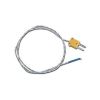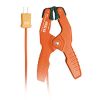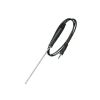Extech 4-Channel Datalogging Thermometer
The Extech 4-Channel Datalogging Thermometer consists of 6 Thermocouple types (J, K, E, T, R,S and 2-channel datalogging with RTD (Pt100Ω) probes.
Features
- User programmable sampling rate: 1 to 3600 seconds
- Built-in PC interface
- Displays [T1, T2, T3, T4] or differential [T1-T2] reading
- Free ground shipping
- Expedited repair and warranty service
- Lifetime technical support
- More
The Extech 4-Channel Datalogging Thermometer displays and stores temperature readings from up to four (4) Type K, J, T, E, R, or S thermocouple temperature probes and two (2) Pt100 RTD probes. The meter stores up to 99 readings manually and 20m readings via the 2G SD card. In addition, an RS232 port allows data streaming to a PC.
- Type J: -148 to 2192 F (-100 to 1200 C)
- Type K: -148 to 2372 F (-100 to 1300 C)
- Type T: -58 to 752 F (-50 to 400 C)
- Type E: -58 to 1652 F (-50 to 900 C)
- Type R: 32 to 3092 F (0 to 1700 C)
- Type S: 32 to 2732 F (0 to 1500 C)
- RTD (Pt100): -327 to 1562 F (-200 to 850 C)
- Resolution: 0.1/1 degree
- Types J,K,E,T,Pt100 Accuracy: +/-0.4% rdg (+1.8 F/+1 C)
- Types R,S Accuracy: +/-0.5% rdg (+2 F/+1 C)
- Datalogging: 20M data records using a 2G SD card
- Dimensions: 7.2x2.9x1.9" (182x73x47.5mm)
- Weight: 17.6oz (500g)
- (1) Datalogging thermometer
- (4) General purpose Type K bead wire temperature probes
- (1) 2GB SD memory card
- (6) AA batteries
- (1) Hard carrying case
In The News
From Paddles to Phytoplankton: Studying Vermont’s Wildest Lakes
For six months of the year, Rachel Cray, a third-year PhD student at the Vermont Limnology Laboratory at the University of Vermont, lives between a microscope and her laptop, running data. For the other six months, she is hiking and canoeing four of Vermont’s lakes, collecting bi-weekly water samples. Cray studies algal phenology across four lakes in Vermont, US, that have low anthropogenic stress—or in other words, are very remote. Funded by the National Science Foundation Career Award to Dr. Mindy Morales, the lakes Cray researches part of the Vermont Sentinel Lakes Program, which studies 13 lakes in the area and, in turn, feeds into the Regional Monitoring Network, which operates in the Northeast and Midwest US.
Read MoreReimagining Water Filtration: How Monitoring and Science Enhance FloWater Filtration Systems
Over 50% of Americans think their tap water is unsafe , according to the Environmental Working Group (EWG). Other recent surveys have found that number to be as high as 70% of persons surveyed. Whether due to increased public awareness of water quality issues or confusion about how municipal water sources are regulated, there is a clear distrust of tap water in the United States. According to industry expert Rich Razgaitis, CEO and co-founder of the water purification company FloWater, this issue creates a damaging cycle. Razgaitis explained that the health and environmental problems associated with contaminated water aren’t the only issues. As people become increasingly aware that some tap water is unsafe, they resort to bottled water.
Read MoreMonitoring New Hampshire’s Aquatic Ecosystems: Continuous Data Collection in the Lamprey River Watershed
New Hampshire’s aquatic ecosystems provide a range of ecosystem services to the state and region. Resources and services like clean water, carbon storage, climate regulation, nutrient regulation, and opportunities for recreation all depend on New Hampshire’s aquatic ecosystems remaining healthy. Jody Potter, an analytical instrumentation scientist at the University of New Hampshire (UNH), is studying these aquatic ecosystems in hopes of developing an improved understanding of ecosystem services and their interactions with climate change, climate variability, and land use changes. [caption id="attachment_39799" align="alignnone" width="940"] Aquatic sensors in the Merrimack River in Bedford, NH, with I-293 in the background.
Read More















